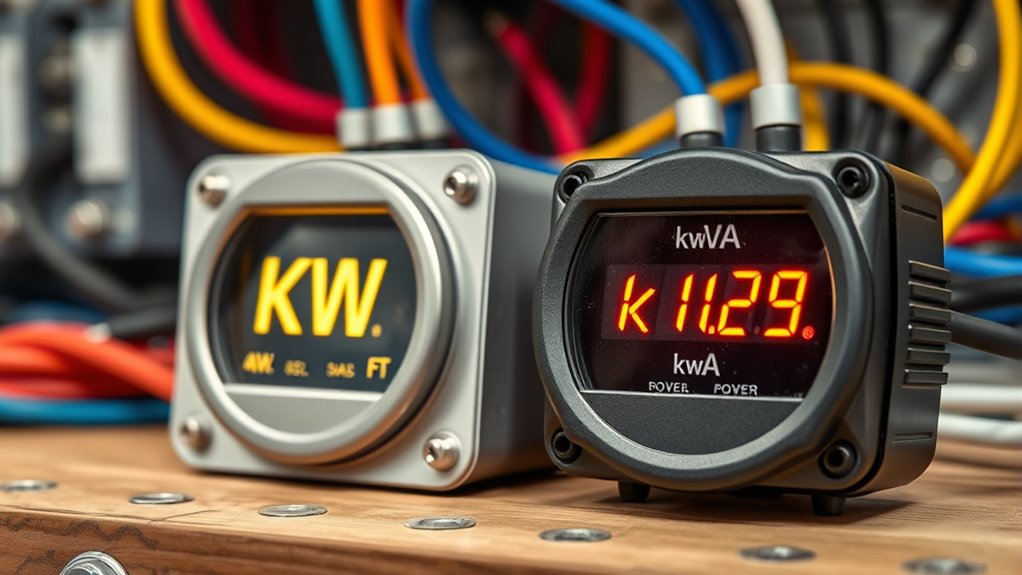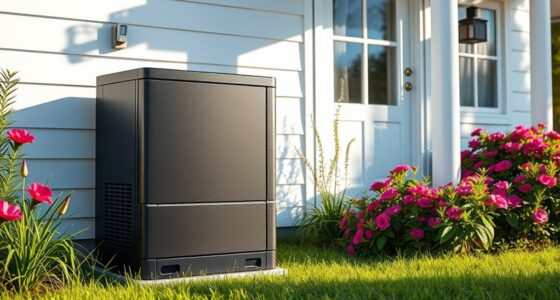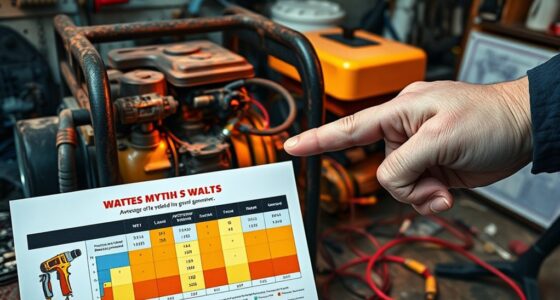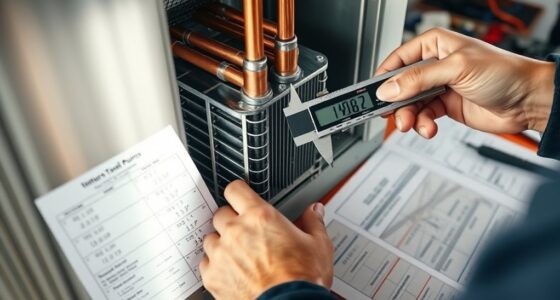In simple terms, kW measures the actual power your appliances use, while kVA accounts for the total power your system supplies, including reactive components like motors. Your power factor shows how efficiently your home uses electricity; a high power factor means less waste. Understanding these differences helps you manage energy better and avoid extra costs. If you want to learn how to optimize your system and save money, keep exploring the details below.
Key Takeaways
- kW measures real power used by appliances, while kVA measures total apparent power including reactive components.
- Power factor indicates system efficiency; a higher power factor means less reactive power and closer kW to kVA.
- Residential electricity billing mainly depends on kW, but low power factor can increase costs due to higher kVA.
- Improving power factor through correction devices reduces apparent power, saves energy, and lowers electrical losses.
- To convert between kW and kVA, divide or multiply by the power factor; understanding both helps optimize system performance.
What Do Kw and Kva Stand For?
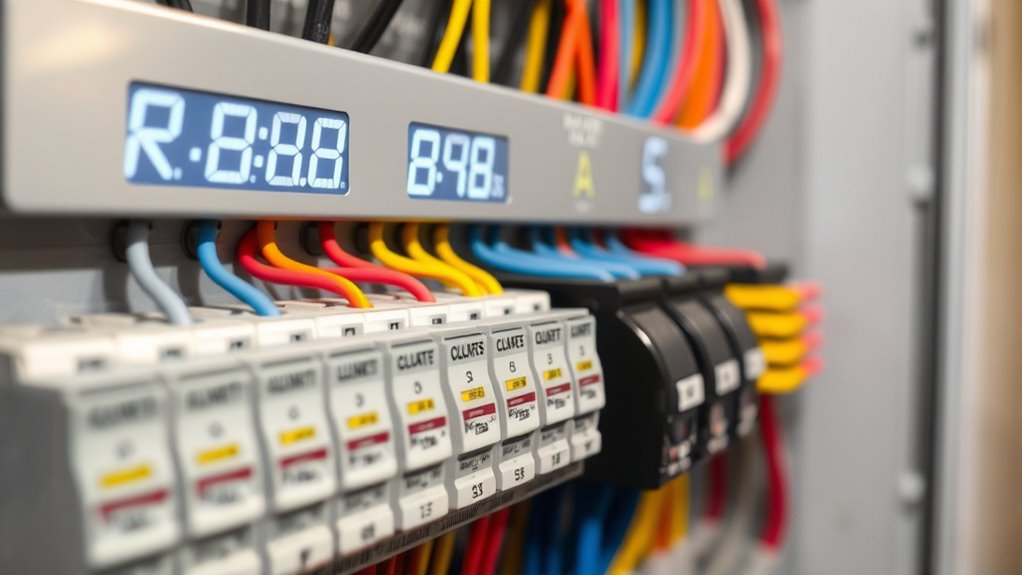
Have you ever wondered what the abbreviations kW and kVA actually mean? Kilowatts (kW) measure the real power you use to run appliances, directly impacting your electrical efficiency. Kilovolt-amperes (kVA), on the other hand, represent apparent power, which includes both real power and reactive power that doesn’t perform any useful work. The power factor, a value between 0 and 1, explains how efficiently your system uses electricity. A higher power factor means less reactive power and better electrical efficiency. Understanding these terms helps you grasp how your system manages power. While kW reflects actual energy consumption, kVA indicates the total capacity your system can handle, including reactive components. This distinction is vital for optimizing residential electrical performance. Additionally, projector bulb maintenance practices can influence your system’s overall efficiency and lifespan, highlighting the importance of understanding power concepts in home setups.
How Do Kw and Kva Differ in Residential Power Use?

You might notice that kilowatts and kilovolt-amperes are used differently when measuring your home’s power. While kilowatts show the actual energy your system consumes, kilovolt-amperes relate to the total electrical power supplied, including reactive aspects. Understanding this difference helps you see how each impacts your residential system’s performance and efficiency. Additionally, recognizing how automation can optimize data analysis may lead to more efficient energy management.
Power Measurement Differences
Understanding the difference between kilowatts (kW) and kilovolt-amperes (kVA) is essential for grasping how your home’s electrical system operates. Power measurement differences stem from how these units account for electrical efficiency and power factor. kW measures real power, the actual energy used by appliances, while kVA accounts for apparent power, which includes reactive power from inductive loads like motors. The key is the power factor, which indicates how efficiently your system converts apparent power into useful work. When power factor is high, kW and kVA are close; when it’s low, they differ more notably. This table helps visualize these concepts:
| Measure | Definition | Affects on Power Use |
|---|---|---|
| kW | Real power used by appliances | Electrical efficiency |
| kVA | Apparent power, including reactive | Power factor impact |
Impact on Residential Systems
In residential systems, the distinction between kW and kVA considerably impacts how your home’s electrical load is managed. Understanding this difference helps optimize energy savings and ensures your appliances operate correctly. When your system’s power is measured in kW, it reflects real energy use, guiding you to avoid overloading circuits and reducing unnecessary consumption. KVA, on the other hand, accounts for the total apparent power, which can lead to mismatched expectations about your home’s capacity. This affects appliance compatibility, especially for devices sensitive to power fluctuations. By knowing whether your system emphasizes kW or kVA, you can make smarter decisions about energy use, upgrade options, and ensuring all your appliances work efficiently without wasting electricity or risking damage. Additionally, understanding the power factor can help you better manage your home’s electrical efficiency and prevent unnecessary costs.
Why Is Power Factor Important?
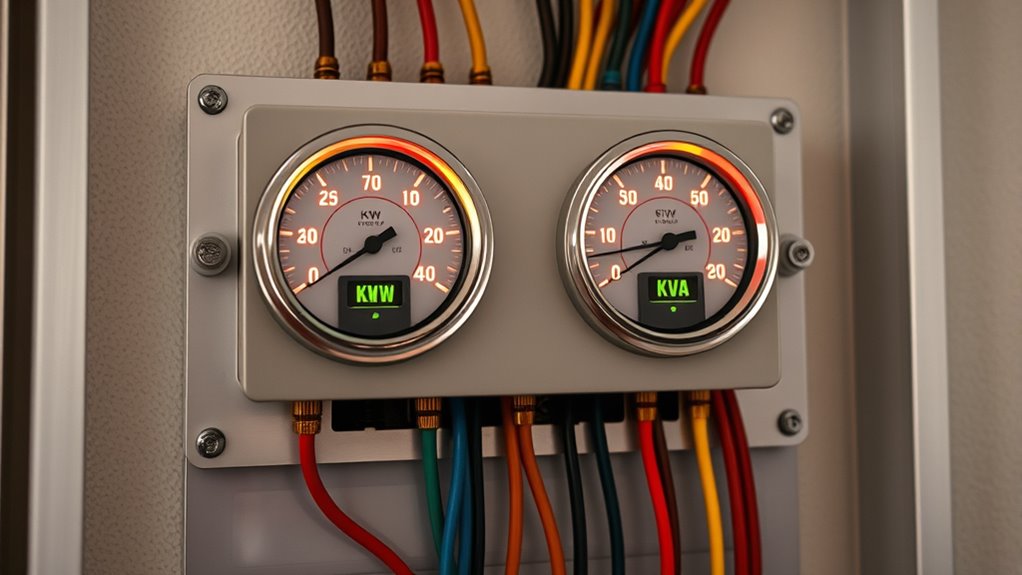
Your power factor affects how efficiently your system uses electricity. A good power factor minimizes energy waste and reduces electrical losses. Improving it helps save money and keeps your home running smoothly. Incorporating sound vibrations and other energy-efficient practices can further enhance overall system performance.
Enhances Energy Efficiency
Have you ever wondered how power factor impacts your home’s energy use? Improving your power factor makes your electrical system more efficient, reducing wasted energy. When your power factor is high, your appliances draw power more effectively, which supports the integration of renewable energy sources like solar panels. This efficiency means less energy is lost during transmission, lowering your overall consumption. Additionally, a better power factor helps your home communicate seamlessly with a smart grid, optimizing energy flow and reducing costs. By maintaining a strong power factor, you’re making your household more energy-efficient, saving money, and supporting a greener environment. Enhanced energy efficiency not only benefits your wallet but also contributes to a more sustainable energy future. Color accuracy in your home’s electrical system can further enhance overall efficiency and performance.
Reduces Electrical Losses
When power factor is low, more electrical energy is lost as heat and resistance within the wiring and equipment. This inefficiency means you’re using more power than necessary to get the same amount of work done. Improving your power factor reduces these losses, which directly boosts electrical efficiency. A higher power factor means less energy is wasted, so your system operates more effectively. This is particularly important in Key Domains of Development in Psychology, as efficient energy use can support a stable and reliable environment. This not only minimizes heat buildup but also helps prevent overloads and reduces strain on your wiring and devices. By maintaining a good power factor, you guarantee that your electrical system runs smoothly, conserving energy and lowering your electricity bills. In short, a high power factor is vital for reducing electrical losses and optimizing your overall energy use in your residential system.
How to Calculate Your Home’s Electrical Power Needs
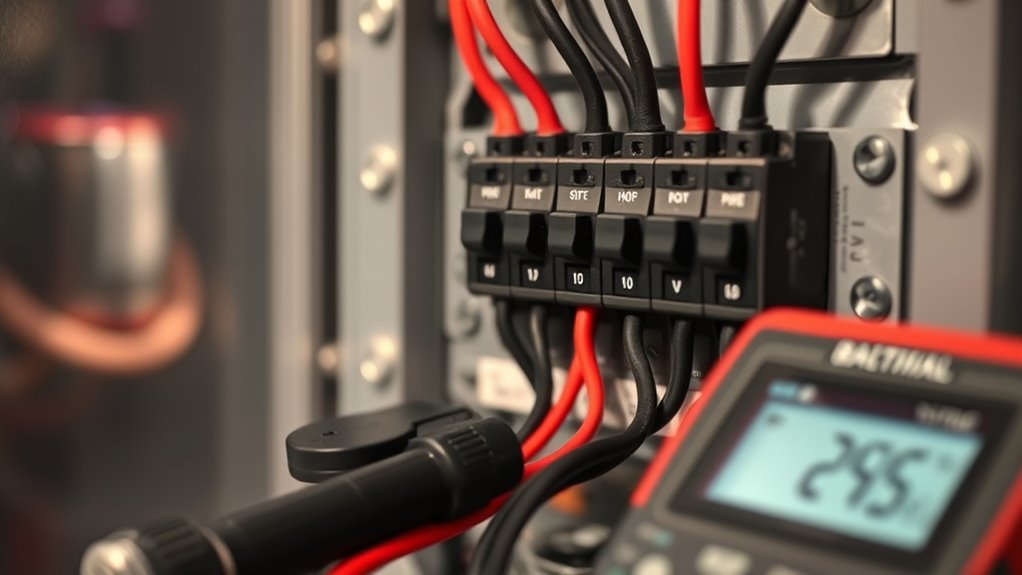
Calculating your home’s electrical power needs is essential to guarantee your system can handle all appliances and devices safely and efficiently. Start by listing every appliance, noting their wattage or amperage, and consider their usage duration. Pay attention to appliance efficiency, as more efficient devices draw less power, reducing overall load. Next, add up the total wattage to determine your peak power requirement. To ensure wiring safety, include a safety margin—typically 20%—to account for future additions or surges. This helps avoid overloading your system. Additionally, understanding the horsepower of electric dirt bikes can be useful when planning for high-power appliances or equipment. Knowing your power needs ensures you select the right circuit breakers and wiring gauge, protecting your home from electrical hazards. Proper calculation minimizes risks and guarantees your electrical system operates smoothly and safely.
Can You Convert Between Kw and Kva?
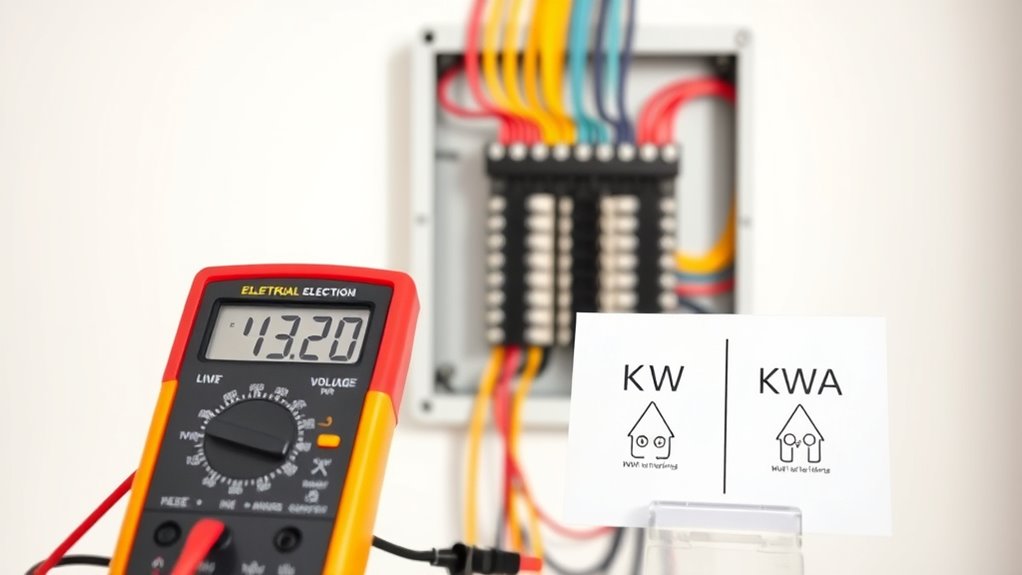
Ever wondered if you can convert between kilowatts (kW) and kilovolt-amperes (kVA)? Yes, it’s possible, but understanding the conversion methods depends on the unit differences and your system’s power factor. Since kW measures real power and kVA measures apparent power, the key is knowing the power factor (PF). To convert kVA to kW, multiply the kVA value by the PF: kW = kVA × PF. Conversely, to find kVA from kW, divide by the PF: kVA = kW ÷ PF. Without knowing the power factor, you can’t accurately perform this conversion. So, while the formulas are straightforward, remember that the unit differences—real versus apparent power—are vital in these calculations. Always verify you have the right power factor for precise conversions. Understanding power factor can significantly improve your ability to manage electrical systems efficiently.
What Does a Power Factor Correction Do?
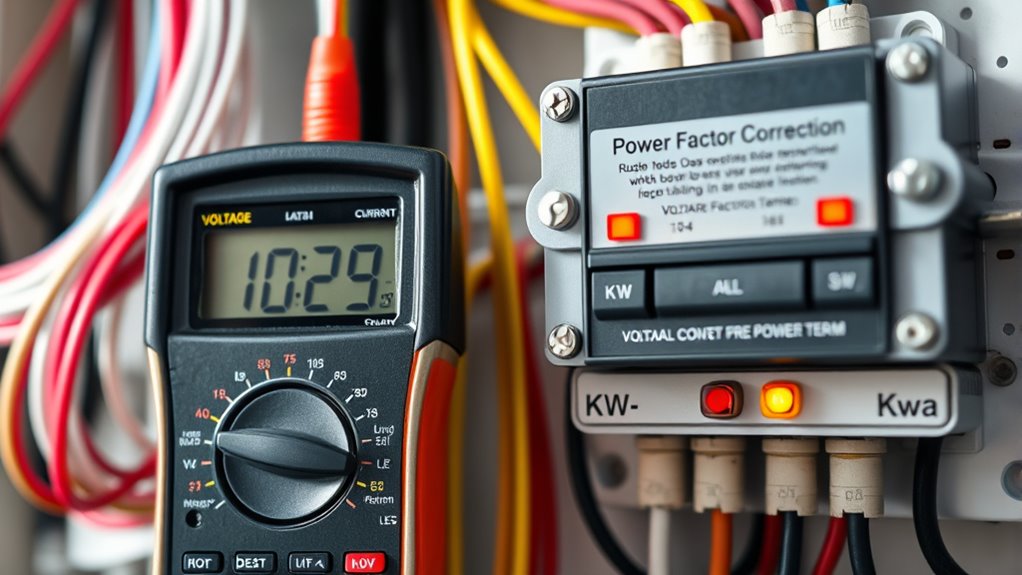
Power factor correction improves the efficiency of your electrical system by reducing the difference between real power (kW) and apparent power (kVA). It does this by adjusting the power factor, which is the ratio of real power to apparent power. When your system has a low power factor, more apparent power is drawn than necessary, leading to wasted energy and higher costs. Power factor correction uses devices like capacitors or reactors to counteract inductive loads, which cause these inefficiencies. By improving your power factor, you decrease the amount of apparent power needed, enhancing electrical efficiency. This means your system runs smoother, consumes less energy, and reduces strain on your electrical infrastructure. Proper system maintenance and regular inspections can further ensure optimal performance. Ultimately, power factor correction helps you save money and prolong the lifespan of your electrical components.
How Do These Terms Affect Your Electricity Bill?
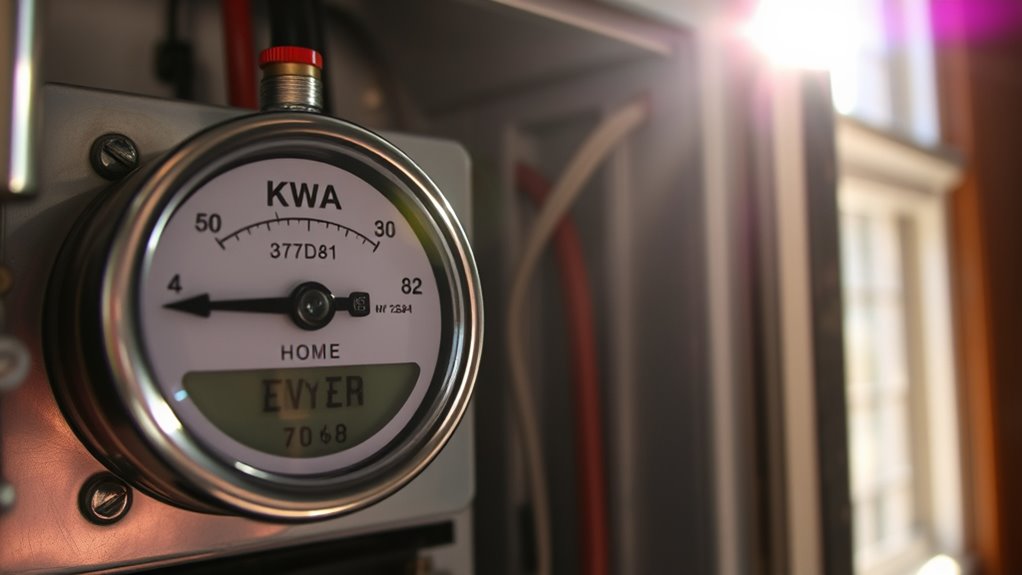
Understanding the difference between kilowatts (kW) and kilovolt-amperes (kVA) is key to grasping how your electricity bill is calculated. Your energy cost depends mainly on the actual power you use, measured in kilowatts. However, many billing systems also consider apparent power in kVA, which can affect billing accuracy if your system has a low power factor. When your power factor is poor, it means you’re consuming more apparent power without using more real energy, increasing your energy cost unnecessarily. Utilities may charge extra for this inefficiency. By understanding these terms, you can better manage your electricity use, ensure billing accuracy, and potentially lower your bills through power factor correction or efficient appliances.
Tips for Understanding Your Home’s Electrical System

To effectively manage your home’s electrical system, start by familiarizing yourself with the main components, such as your circuit breaker panel, outlets, and appliances. Understanding these parts helps you recognize how voltage stability impacts your system’s performance and safety. Always verify your circuit protection devices, like circuit breakers and fuses, are in good condition to prevent overloads or short circuits. Regularly check for signs of voltage fluctuations, which can damage appliances or cause inefficiencies. Knowing how your system is wired and where the main shutoff is located can save you time during emergencies. By keeping an eye on circuit protection and voltage stability, you’ll better maintain a safe, reliable electrical system in your home.
Frequently Asked Questions
Can I Use Kw and Kva Interchangeably for Residential Appliances?
You can’t use kW and kVA interchangeably for residential appliances because they measure different things. kW reflects appliance efficiency and actual power consumption, while kVA relates to apparent power, which includes electrical safety considerations. Using them interchangeably may lead to overloads or safety issues. Always check appliance specifications to guarantee proper sizing and safe operation, and remember that real power (kW) is what determines energy use, not apparent power (kVA).
How Does Voltage Affect the Difference Between Kw and Kva?
Voltage impacts the difference between kW and kVA because it influences your system’s power factor and voltage regulation. Higher voltage can improve power factor, reducing the gap between kW and kVA, while lower voltage may cause more reactive power, increasing kVA without affecting actual power (kW). You should contemplate voltage stability and power factor to guarantee your appliances operate efficiently and avoid overloading your system.
What Are Common Signs of Poor Power Factor at Home?
Think of poor power factor at home like a noisy orchestra—your appliances struggle to perform efficiently. Signs include flickering lights, frequent breaker trips, and equipment that runs hot or slows down. These issues hurt your power quality and reduce energy efficiency. When you notice such signs, it’s time to check your system’s power factor. Improving it boosts overall performance, helps save on energy costs, and keeps your home running smoothly.
Is Power Factor Correction Necessary for Residential Systems?
Power factor correction isn’t always necessary for residential systems, but it can improve your home’s energy efficiency if you notice high electricity bills or equipment issues. By correcting your power factor, you reduce energy waste and lower your overall costs. If you experience frequent electrical problems or want to optimize your energy use, investing in power factor correction helps guarantee your system runs smoothly and efficiently.
How Do Renewable Energy Sources Impact Kw and Kva Measurements?
Renewable energy sources, like solar or wind, impact power measurement by increasing the focus on kilowatts (kW) because they generate real power for your home. However, they can also influence kilovolt-amperes (kVA) due to the variability and power factor. You need to monitor both measurements to guarantee your system operates efficiently, as renewable energy can introduce fluctuations that influence your overall power consumption and capacity.
Conclusion
Think of your home’s electrical system as a well-orchestrated band. Understanding the difference between kW and kVA is like knowing the instruments’ roles—each essential for harmony. Just as a conductor ensures every musician plays in sync, managing power and power factor maintains your system efficient. By mastering these terms, you’re conducting your home’s energy flow smoothly, avoiding unnecessary noise and costs. Keep tuning in, and your electrical performance will always hit the right note.
